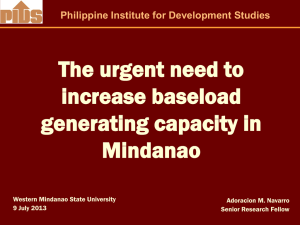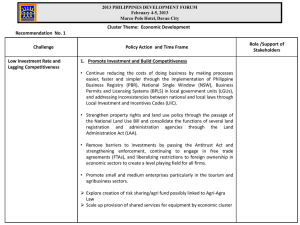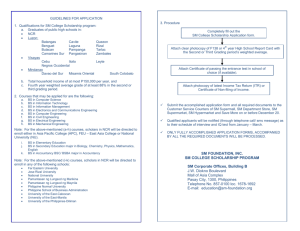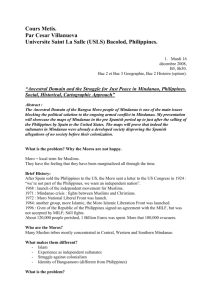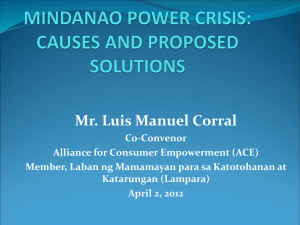3 FINAL - Management Association of the Philippines
advertisement
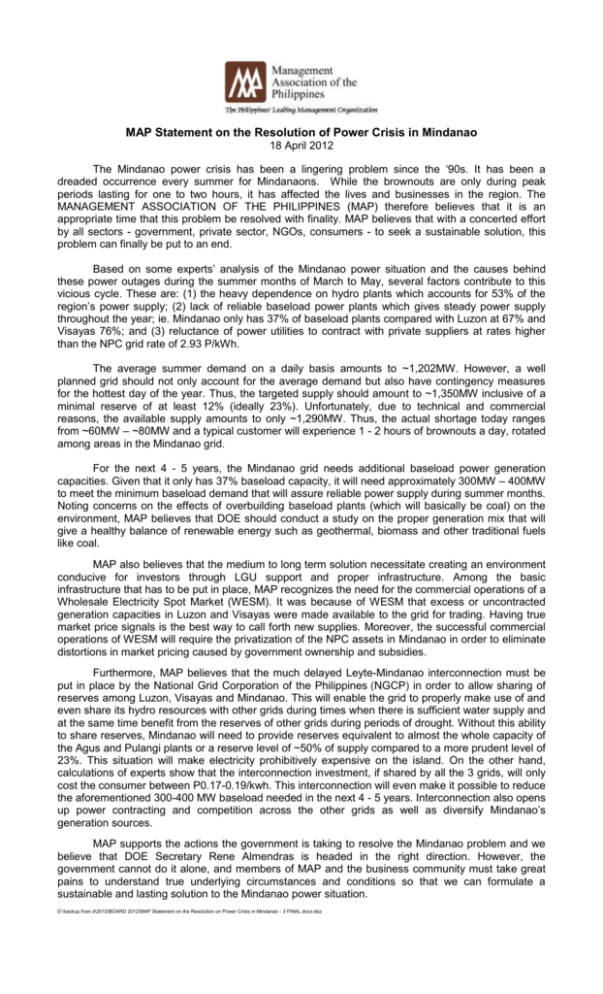
MAP Statement on the Resolution of Power Crisis in Mindanao 18 April 2012 The Mindanao power crisis has been a lingering problem since the ‘90s. It has been a dreaded occurrence every summer for Mindanaons. While the brownouts are only during peak periods lasting for one to two hours, it has affected the lives and businesses in the region. The MANAGEMENT ASSOCIATION OF THE PHILIPPINES (MAP) therefore believes that it is an appropriate time that this problem be resolved with finality. MAP believes that with a concerted effort by all sectors - government, private sector, NGOs, consumers - to seek a sustainable solution, this problem can finally be put to an end. Based on some experts’ analysis of the Mindanao power situation and the causes behind these power outages during the summer months of March to May, several factors contribute to this vicious cycle. These are: (1) the heavy dependence on hydro plants which accounts for 53% of the region’s power supply; (2) lack of reliable baseload power plants which gives steady power supply throughout the year; ie. Mindanao only has 37% of baseload plants compared with Luzon at 67% and Visayas 76%; and (3) reluctance of power utilities to contract with private suppliers at rates higher than the NPC grid rate of 2.93 P/kWh. The average summer demand on a daily basis amounts to ~1,202MW. However, a well planned grid should not only account for the average demand but also have contingency measures for the hottest day of the year. Thus, the targeted supply should amount to ~1,350MW inclusive of a minimal reserve of at least 12% (ideally 23%). Unfortunately, due to technical and commercial reasons, the available supply amounts to only ~1,290MW. Thus, the actual shortage today ranges from ~60MW – ~80MW and a typical customer will experience 1 - 2 hours of brownouts a day, rotated among areas in the Mindanao grid. For the next 4 - 5 years, the Mindanao grid needs additional baseload power generation capacities. Given that it only has 37% baseload capacity, it will need approximately 300MW – 400MW to meet the minimum baseload demand that will assure reliable power supply during summer months. Noting concerns on the effects of overbuilding baseload plants (which will basically be coal) on the environment, MAP believes that DOE should conduct a study on the proper generation mix that will give a healthy balance of renewable energy such as geothermal, biomass and other traditional fuels like coal. MAP also believes that the medium to long term solution necessitate creating an environment conducive for investors through LGU support and proper infrastructure. Among the basic infrastructure that has to be put in place, MAP recognizes the need for the commercial operations of a Wholesale Electricity Spot Market (WESM). It was because of WESM that excess or uncontracted generation capacities in Luzon and Visayas were made available to the grid for trading. Having true market price signals is the best way to call forth new supplies. Moreover, the successful commercial operations of WESM will require the privatization of the NPC assets in Mindanao in order to eliminate distortions in market pricing caused by government ownership and subsidies. Furthermore, MAP believes that the much delayed Leyte-Mindanao interconnection must be put in place by the National Grid Corporation of the Philippines (NGCP) in order to allow sharing of reserves among Luzon, Visayas and Mindanao. This will enable the grid to properly make use of and even share its hydro resources with other grids during times when there is sufficient water supply and at the same time benefit from the reserves of other grids during periods of drought. Without this ability to share reserves, Mindanao will need to provide reserves equivalent to almost the whole capacity of the Agus and Pulangi plants or a reserve level of ~50% of supply compared to a more prudent level of 23%. This situation will make electricity prohibitively expensive on the island. On the other hand, calculations of experts show that the interconnection investment, if shared by all the 3 grids, will only cost the consumer between P0.17-0.19/kwh. This interconnection will even make it possible to reduce the aforementioned 300-400 MW baseload needed in the next 4 - 5 years. Interconnection also opens up power contracting and competition across the other grids as well as diversify Mindanao’s generation sources. MAP supports the actions the government is taking to resolve the Mindanao problem and we believe that DOE Secretary Rene Almendras is headed in the right direction. However, the government cannot do it alone, and members of MAP and the business community must take great pains to understand true underlying circumstances and conditions so that we can formulate a sustainable and lasting solution to the Mindanao power situation. D:\backup from d\2012\BOARD 2012\MAP Statement on the Resolution on Power Crisis in Mindanao - 3 FINAL.docx:ebz

